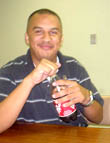|
|
This topic comprises 4 pages: 1 2 3 4
|
|
Author
|
Topic: When to strike the Xenon in the morning
|
Bill Langfield
Master Film Handler

Posts: 280
From: Prospect, NSW, Australia
Registered: Apr 2001
|
 posted 08-23-2004 01:50 PM
posted 08-23-2004 01:50 PM





My experience at every theatre I've ever worked is that you strike the Xenon 30 minutes
before first session of the day.
The reasons:
1/ Sometimes those Strong X's can be bastards. (Even some Xebex Supers)
2/ Strike the Xenon before amps rack/automation is on to avoid spikes to them.
3/ Allows the bulb to warm and settle.
4/ If the bulb wont strike, you have time to fault find.
5/ If the bulb crapped itself the night before, you have time to replace it.
However the new 'tech' has decided that the Xenon should be struck up by the automation on the last slide, in other words, around 10 seconds before the film hits the sheet.
Is that TOTAL madness? Or is it just me?
Is it not just ASKING for trouble?
That being said, what is the general feeling about WHEN to strike up for the first show of the day?
(Btw, this just ONE of mad ideas this 'tech' is turning the place upside down with)
Hi Barry, this post was for you. I was glad you called tonight, your the BEST theatre installer/technician in the country. And stop lurking, sign up.
| IP: Logged
|
|
|
|
|
|
|
|
John Pytlak
Film God

Posts: 9987
From: Rochester, NY 14650-1922
Registered: Jan 2000
|
 posted 08-23-2004 02:09 PM
posted 08-23-2004 02:09 PM





First, I assume your system is designed and installed properly(e.g., shielding, separate circuits and UPS for sound processors), to minimize any audible effect of the xenon ignition pulse in the sound. If not, it should be corrected.
I don't really think it is necessary to run the lamp all day if there is a long time between shows. General "rule of thumb" is that each lamp ignition decreases lamp life by about one hour, so if the time between shows/reels is less than an hour, the lamp should be left on, with the dowser closed (assuming you have a dowser that can take the heat load without warping or being damaged).
I agree with you that it is a good idea to strike the lamp more than just a few seconds before the film needs to be projected. At least a few minutes would allow better stabilization of the arc, and a bit of "breathing time" to remedy things if the lamp does not ignite.
More than that would even allow time for changing a lamp, but is probably an unnecessary waste of electricity.
| IP: Logged
|
|
Bill Langfield
Master Film Handler

Posts: 280
From: Prospect, NSW, Australia
Registered: Apr 2001
|
 posted 08-23-2004 02:10 PM
posted 08-23-2004 02:10 PM





Jeremy,
Can you please EXPLAIN your POINT or what you don't understand?
That said, I just remembered another location with Vic5 'console' built in lamphouses that have no standby, OVERHEAT between shows, so the automation turns the lamp off after every show, and strikes it up, 10 seconds before the next show.
So I have just killed my own agument very quickly. Damn it.
And the kicker is, Im told the on/off lamps are lasting longer.
Oh no JOHN, now I'm in trouble.(Did'nt expect you to chime in) You missed most of my point too.
The automation just tries igntion ONCE, if the lamp is long in tooth it might not light.
This is all about striking-up 10 seconds before the FIRST show of the day, nothing to do with leaving them on all day or if there was an hour between sessions. Granted 30 minutes might be too much.
How about I meet you half way at 10 or 15 minutes?
But when you have projection room the length of a football field, I'd like to be comfortable that cinema 16 is fired up and ready to go, while I'm getting cinema 1 ready. I dont want hear over the 2-way that cinema 16 has not fired the Xenon and have run down there. (we had scooters, but they got banned)
| IP: Logged
|
|
Stephen Furley
Film God

Posts: 3059
From: Coulsdon, Croydon, England
Registered: May 2002
|
 posted 08-23-2004 03:05 PM
posted 08-23-2004 03:05 PM




I recently did some projection at a place with a pair of Kinotons. The lamps strike on the motor start, and there is no way to strike them earlier. This place is running changeovers, and the eight seconds the lamp has before the actual changeover is not long enough. The picture is noticably dimmer, and the colour is different, after a changeover. It seems to take about 30 seconds to one minute to reach maximum light output. These are small lamps, I don't know if large ones would take longer.
I think anywhere between two and five minutes is a reasonable time to strike the lamp. I can't see any point in doing it earlier. It's unlikely that you wouldn't be able to get a lamp going in that time, another than a lamp exploding, and in the unlikely event that happens, the show will be late starting. Striking the lamp 30 minutes early won't help you if something goes wrong after 29 minutes.
| IP: Logged
|
|
|
|
|
|
|
|
|
|
|
|
|
|
Brad Miller
Administrator

Posts: 17775
From: Plano, TX (36.2 miles NW of Rockwall)
Registered: May 99
|
 posted 08-23-2004 08:42 PM
posted 08-23-2004 08:42 PM




Again this is where the mighty CA21 comes in handy for platter multiplexes, as it can be configured to do anything you want it to do, even years after it was installed.
Personally, I have removed all of the electric dousers since about 2001. They are a pain (especially the Christie ones) and are just not needed in a platter booth. Instead I have a stretch of opaque black film at the end of each threading leader. The projectionist threads on the frameline leader, then when the show is started the motor runs until the start cue hits, where the xenon turns on (blasting onto the opaque film, so it looks to the audience like the douser is closed), then after a pre-programmed delay (currently 30 seconds) the non-sync fades out and the first green band hits the screen as the sound changes over. No dousers to jam, no arc stabilization issues, no problems...ever. ![[thumbsup]](graemlins/thumbsup.gif)
Bill, I think you will find that proper cooling will add more life to the xenon than any other factor. The sides and front of my lamphouses with proper cooling are just barely warmer than room temperature.
| IP: Logged
|
|
|
|
|
|
All times are Central (GMT -6:00)
|
This topic comprises 4 pages: 1 2 3 4
|
Powered by Infopop Corporation
UBB.classicTM
6.3.1.2
The Film-Tech Forums are designed for various members related to the cinema industry to express their opinions, viewpoints and testimonials on various products, services and events based upon speculation, personal knowledge and factual information through use, therefore all views represented here allow no liability upon the publishers of this web site and the owners of said views assume no liability for any ill will resulting from these postings. The posts made here are for educational as well as entertainment purposes and as such anyone viewing this portion of the website must accept these views as statements of the author of that opinion
and agrees to release the authors from any and all liability.
|

 Home
Home
 Products
Products
 Store
Store
 Forum
Forum
 Warehouse
Warehouse
 Contact Us
Contact Us




 Printer-friendly view of this topic
Printer-friendly view of this topic











![[Roll Eyes]](rolleyes.gif) Really though, with good lamps and good bulbs for normal commercial purposes this system seems to work fine in most cases, with decent presentation and decent bulb life.
Really though, with good lamps and good bulbs for normal commercial purposes this system seems to work fine in most cases, with decent presentation and decent bulb life.



![[beer]](graemlins/beer.gif)

![[thumbsup]](graemlins/thumbsup.gif)




